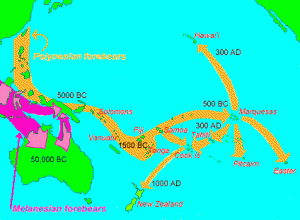New Zealand scientists have used language to plot the origins of most populations in the islands of South East Asia and the Pacific back to Taiwan around 5200 years ago.

A team at the University of Auckland used computer analysis to compare the traits of 400 Austonesian languages, tracing how they evolved. The relationships between the languages give scientists a detailed history of settlement in the Pacific. The research is published in the journal Science
“We analysed the data from 400 of the languages in this database using computational phylogenetic methods to build a set of ‘family’ trees for the languages of the Pacific,” explained Professor Russell Gray of the University of Auckland’s Department of Psychology.
“The results clearly show that the origin of the entire Austronesian language family can be dated back to Taiwan around 5,200 years ago, and moved through Island South-East Asia, along New Guinea and into Polynesia,” he added.
“We show that this entire spread of people and the settling of the Pacific proceeded through a series of expansion pulses and settlement pauses. We can link these pulses to the development of new technology – better canoes, farming, social techniques to deal with the inter-island distances in Polynesia etc.”
Registered journalists can log into the SMC resource library to access the research. More…
The SMC rounded up comment from other experts on the research findings:
Mike Hendy Professor of Mathematical Biology at Massey University and Executive Director of the Allan Wilson Centre for Molecular Biology and Evolution comments:
“Professor Gray and his colleagues have made several major advances in understanding the evolution of languages by successfully adapting the methods developed for finding evolutionary trees from DNA for various species.
“In particular by modelling language development they have been able to add a time dimension to give more accurate historical perspectives. This New Zealand team are now world leaders in exploiting language comparisons to interpret human migration histories.”
Lisa Matisoo-Smith, Associate Professor of Anthropology at the University of Auckland and researcher at the Allan Wilson Centre comments:
“Gray et al. provide some very compelling evidence for the timing and process of the expansion of Austronesian languages.
“While these linguistic patterns are important to consider when interpreting patterns of modern genetic variation and reconstructing culture history, language phylogenies do not necessarily fully explain the biological or social history of populations.
“As the authors explain, Austronesians mixed biologically and culturally with existing populations as they passed through Island Southeast Asia and Near Oceania, and populations continued to mix after that initial contact and indeed still do today.
“Rather than providing a definitive explanation for the human settlement of the Pacific, as many might suggest, the value of this research is the demonstration of the power of the new phylogenetic methods and the analyses of large databases. Gray et al. have provided a valuable and refined framework that allows us to reject a Wallacean origin for Austronesian language expansion and one that can now be compared to and incorporated with analyses of ever improving genetic and archaeological data and dates to allow for more complex holistic reconstructions of the last 5000 years of Pacific prehistory.”
Professor David Penny, Professor of Theoretical Biology at Massey University and the Allan Wilson Centre comments:
“The team of Professor Gray has made a major contribution to our understanding of the timing and origin of the Polynesian peoples.
“Their picture of languages, combined with archeology, culture, and mothers’ genetics coming out of Taiwan, is a powerful consensus – it shows the advantage both of combining different data sets, and the power that good mathematics can bring to our evaluation.
“There are still fascinating and important questions for the future, for example the timing of the male genes joining into the ancestral female Polynesian lineages is a fascinating problem. Good data needs good analyses and we have certainly got it for the evolution of Pacific languages.”
FAQ on Professor Gray’s research: More information available here.
Is this lexicostatistics?
No. Lexicostatistics calculates an overall cognate similarity measure to link languages into subgroups. Our methods are character-based, and assess the fit of every single cognate set in the data.
Are your date estimates based on glottochronology?
No. Our methods do not assume a single constant rate of change over time. Instead, we use a method (“Penalised Likelihood Rate Smoothing”) that allows us to “smooth” the observed rates of change across the trees whilst taking into account historical information as “calibration points”. This allows certain languages and subgroups to change at different rates over time. In addition, since we calculated these age estimates across a distribution of trees, we have a confidence interval around each age estimate.
What about Thor Heyerdahl’s theory that the Polynesians came from South America?
There is no evidence that the Polynesians originated in the Americas, and most modern researchers consider this very unlikely. Instead, the genetic, linguistic, and archaeological evidence all point towards an origin in Taiwan.
Languages borrow from each other – how would this have affected your results?
In our database we have a lot of loan words identified. We removed these from the analysis. In addition, we avoided using languages that are known to be creoles or have “hybrid” histories.
More importantly, our methods are actually very robust to borrowing between languages (we are working on a study showing this at the moment), and even reasonably high levels of borrowing are unlikely to have biased our results.
Paper co-author Russell Gray arrives back in New Zealand the morning of Friday, January 23.
Mobile: (0064) (0)21 059 2405
Email: rd.gray@auckland.ac.nz